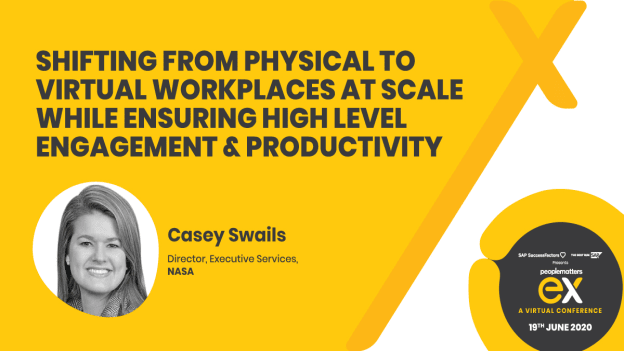Focus on people and safety first: Casey Swails, NASA

“It is interesting how much things have changed in the last few months,” stated Casey Swails, Director, Executive Services, NASA in her opening keynote. Shifting from a physical to a virtual workplace while ensuring high-level engagement and productivity seems like a cool HR problem statement; however, Casey admitted that it was not what she was thinking about in January. It was a huge challenge for NASA as well just like any other organization which was aiming to put the next astronauts on the moon by 2024 as COVID-19 struck.
Given the complexities involved in such an ambitious mission, it is difficult to visualize a completely virtual workplace or a workforce for that matter. Yet, on May 30th, NASA managed to launch the first human commercial space flight in partnership with SpaceX. And planning for a global pandemic was certainly not a part of the extensive contingency planning that NASA does for such missions. Yet in January, the agency had to think of moving 90% of its workforce to a virtual environment practically overnight.
It's not easy to launch rockets virtually
While it's not easy to launch rockets virtually, in some ways the agency was well positioned- such having the technical tools and environment handy to do it and the fact that they had been working in a virtual environment for a decade. And now they just needed to leverage it. If you think of the most critical employees such as the astronauts, they are also used to working in a remote environment. So in these ways, NASA was equipped.
However, in some respects, they were really not prepared-such as having labs and facilities that are one of a kind and cannot be replicated virtually. Also, many of the employees are used to being physically co-located, and hence not many supervisors have any experience to leading virtually as most of the employees are onsite.
So what did HR do to deal with that?
Focus on people and safety first
The first thing the HR team made sure was to focus on people and their safety first. It is an easy thing to say but a difficult thing to do. The firm took an intentional call of putting people first realizing it will have financial and mission impacts involved. The agency also encouraged people to put their safety first. Every employee has different individual circumstances-lot of support systems and schools were closed and employees were struggling to look after their dependents. A lot of employees were stressed about being online the whole day but giving them flexibility and taking that intentional pause for folks to take care of themselves really increased engagement and productivity. In fact, employees were working more as a result. The firm adjusted to the new normal and that included building in breaks as a new priority. People adjusted to being on a telephone call from being on camera for meetings.
In addition, NASA provided paid leave for dependent care to support employees. This encouraged help balance work and home life. It also continuously posted information about COVID-19 as a one-stop-shop on its website to guide employees. While critical training of the astronauts continued, it was done with all safety protocols in place.
Empower remote leaders to empower employees
In continuing with the focus on safety, the agency kept up the communication on safety, encouraging employees to voice their concerns if they are uncomfortable.
Also, the firm ensured that first-line supervisors are set up for success to empower and lead teams given they did not have much experience in leading virtually. NASA made sure of this by sending them frequent emails and links with resources to take care of themselves and their teams, nudging them in how to pause, assess and reconnect, and by conducting agency-wide training sessions for around 800-1,000 supervisors on a variety of topics from leading a team to set up remote workspaces to creative ways of meeting the mission.
Focus on human connection and communication
From procurement to planning, it is easy to do things physically. But even virtually, NASA made sure that employees feel connected to the mission of their work, understand the impact it made on the nation and the community, understood the mission, and found creative ways to connect them. From virtual games to show your pet at workday to say Hi to kids while they walk in on a call, it made sure the human connect remains strong. This way engagement becomes easy when people are excited about the work and the teams.
Making sure that the communication from supervisors is authentic and vulnerable, taking the time to meet family members, not judging the employee’s environment, and encouraging positive intent as a leader is what NASA focused on extensively. The firm also focused on creating watercooler conversations in a virtual environment.
Ultimately, as we go through this pandemic, organizations need to recognize that human connection is critical and focus on more creative ways to encourage collaboration.
Follow #PMEXConf to read more insightful stories from the conference.

















